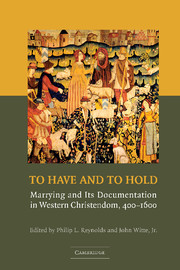Book contents
- Frontmatter
- Contents
- List of Contributors
- Preface and Acknowledgments
- List of Abbreviations
- 1 Marrying and Its Documentation in Pre-Modern Europe: Consent, Celebration, and Property
- 2 Marrying and Its Documentation in Later Roman Law
- 3 Marrying and the Tabulae Nuptiales in Roman North Africa from Tertullian to Augustine
- 4 Dotal Charters in the Frankish Tradition
- 5 Marriage and Diplomatics: Five Dower Charters from the Regions of Laon and Soissons, 1163–1181
- 6 Marriage Agreements from Twelfth-Century Southern France
- 7 Marriage Contracts in Medieval England
- 8 Marriage Contracts and the Church Courts of Fourteenth-Century England
- 9 Marrying and Marriage Litigation in Medieval Ireland
- 10 Marriage Contracts in Medieval Iceland
- 11 Contracting Marriage in Renaissance Florence
- 12 Marital Property Law as Socio-Cultural Text: The Case of Late-Medieval Douai
- 13 Marriage Contracts, Liturgies, and Properties in Reformation Geneva
- Index
1 - Marrying and Its Documentation in Pre-Modern Europe: Consent, Celebration, and Property
Published online by Cambridge University Press: 12 September 2009
- Frontmatter
- Contents
- List of Contributors
- Preface and Acknowledgments
- List of Abbreviations
- 1 Marrying and Its Documentation in Pre-Modern Europe: Consent, Celebration, and Property
- 2 Marrying and Its Documentation in Later Roman Law
- 3 Marrying and the Tabulae Nuptiales in Roman North Africa from Tertullian to Augustine
- 4 Dotal Charters in the Frankish Tradition
- 5 Marriage and Diplomatics: Five Dower Charters from the Regions of Laon and Soissons, 1163–1181
- 6 Marriage Agreements from Twelfth-Century Southern France
- 7 Marriage Contracts in Medieval England
- 8 Marriage Contracts and the Church Courts of Fourteenth-Century England
- 9 Marrying and Marriage Litigation in Medieval Ireland
- 10 Marriage Contracts in Medieval Iceland
- 11 Contracting Marriage in Renaissance Florence
- 12 Marital Property Law as Socio-Cultural Text: The Case of Late-Medieval Douai
- 13 Marriage Contracts, Liturgies, and Properties in Reformation Geneva
- Index
Summary
This anthology focuses on the agreements that marrying entailed in Western Christendom from 400 to 1600, and on the documentation of such agreements. It is appropriate at the outset, therefore, to reflect synoptically on the process of marrying. What agreements were made and who made them? What was the function of such agreements in the process of marrying? Which agreements were documented and which were oral? What other actions did the process of marrying entail, as well as agreements, and what were their functions? The following sketch is intended to provide an overarching historical and conceptual framework for the specialized chapters that follow, to explain some of the terms, concepts, and institutions that the authors presuppose, and to direct the reader to some of the pertinent secondary literature.
Marriage brought about three kinds of social change, pertaining respectively to a core relationship, to a redistribution of property, and to a reconfiguration of family connections. First, and most fundamentally, a man (or boy) and a woman (or girl) entered into the core relationship that was marriage itself. They became, in certain respects, a social unit, forming a partnership (societas) characterized by a cluster of sexual, collaborative, parental, and familial obligations. Because the couple became a new family unit, marriage severed a son from his parents even in virilocal societies. Thus according to Genesis 2:24, a text that surely presupposed a virilocal norm, the man who marries leaves his father and mother to be united with his wife: he does not need to leave his parents' home, but he does leave their embrace.
- Type
- Chapter
- Information
- To Have and to HoldMarrying and its Documentation in Western Christendom, 400–1600, pp. 1 - 42Publisher: Cambridge University PressPrint publication year: 2007
- 1
- Cited by



